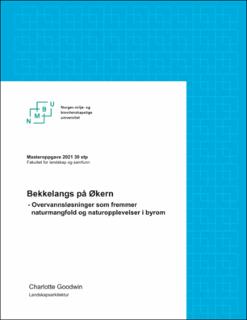| dc.contributor.advisor | Ødegård, Ingrid Merete | |
| dc.contributor.author | Goodwin, Charlotte | |
| dc.coverage.spatial | Norway, Oslo | en_US |
| dc.date.accessioned | 2021-12-14T14:32:24Z | |
| dc.date.available | 2021-12-14T14:32:24Z | |
| dc.date.issued | 2021 | |
| dc.identifier.uri | https://hdl.handle.net/11250/2834255 | |
| dc.description.abstract | Fortetting og transformasjon går ofte på bekostning av det opprinnelige naturgrunnlaget og synergiene mellom landskapet, byen og menneskene som lever der. Når urbane områder stadig blir tettere, er det uunngåelig at andelen permeable overflater og grønne områder avtar. Med nye utfordringer innenfor vannhåndtering, naturmangfold og folkehelse, må vi derfor forsøke å redusere ulempene denne fortettingen medfører. Dette skaper et økende behov for nye tilnærminger til hvordan blågrønne strukturer kan brukes planmessig for å redusere problemer knyttet til flom og overvann og samtidig sikre naturmangfold, rekreasjonsverdier, og naturopplevelser for en økende bybefolkning.
I dag planlegges Oslos største utviklingsområde på Økern, med 30-40 000 nye boliger som skal huse rundt 100 000 mennesker. De siste 60 årene har Økern gjennomgått en vekst der grå og tette flater har gått på bekostning av områdets blågrønne strukturer. Når området igjen skal transformeres er det derfor et stort behov for en omstilling som tilrettelegger for å trekke naturen inn i byen ved å bruke overvannet som en ressurs. Dette danner bakteppet for oppgavens problemstilling:
Hvordan kan overvannsløsninger i byrom i nye Økern sentrum bidra til økt naturmangfold og naturopplevelser?
Gjennom oppgaven undersøkes det hvordan overvannsløsninger i nye Økern sentrum kan bidra til en bedre klimatilpasning, økt biologisk mangfold og naturopplevelser i det urbane bymiljøet. Oppgaven belyser viktigheten av blågrønne strukturer i byutviklingen og hvordan blågrønne strukturer kan tilrettelegge for økt naturmangfold, klimatilpasning, og naturopplevelser. Samtidig må det tas hensyn til arealpress, høy brukerfrekvens og en omfattende infrastruktur innenfor planområdet. Det blir dermed særlig viktig at de blågrønne arealene er av god kvalitet og bidrar til et robust urbant landskap som gagner både mennesker, dyre- og planteliv.
På grunnlag av teori, empiri og analyser utarbeides et utformingsforslag til hvordan nye Økern sentrum kan utformes på en måte som svarer på ovennevnte problemstilling. Oppgaven viser prinsipper som kan styrke økologiske og miljømessige effekter av overvannshåndtering og viser hvordan de kan brukes i utformingen av nye Økern sentrum. Utformingen skal fremme biologisk mangfold og sikre at den blågrønne strukturen kan håndtere store vannmengder ved flom. I tillegg skal den tilrettelegge for menneskelige naturopplevelser og kontakt med naturen. | en_US |
| dc.description.abstract | Urbanization and transformation often occur at the expense of an area’s natural environment and the pre-existing synergies between the landscape, city and people who live there. As urban areas become increasingly densified, the share of available permeable surfaces and green spaces is inevitably reduced. With new challenges facing stormwater management, natural diversity and public health, we must therefore seek to reduce the negative impacts of this urbanization. This creates a growing need for new approaches to utilizing blue-green infrastructure as a planning tool for reducing stormwater and flooding problems while simultaneously securing natural diversity, recreational values and nature experiences for a growing city population.
Today Oslo’s largest development area, the Økern district, is being planned, with 30-40 000 new housing units being built to house approximately 100 000 people. For the past 60 years the Økern district has experienced expansion to the detriment of the area’s blue-green infrastructure. As the area is redeveloped, a re-prioritization that aims to support the re-establishment of nature in the city by using stormwater as a resource is crucial. This re-prioritization forms the basis of the thesis research question:
How can stormwater management solutions in urban spaces in the new Økern district center contribute to increase biodiversity and nature experiences?
This master’s thesis examines how stormwater management solutions in the new Økern district center can contribute to better climate adaptation, increased biodiversity and nature experiences in the urban cityscape. The thesis highlights the importance of blue-green infrastructure in urban planning and development processes and looks at the ways in which blue-green infrastructure can facilitate increased biodiversity, climate adaptation and nature experiences. At the same time, attention must be given to areas under pressure, with high user-frequencies and a substantial pre-existing infrastructure in the planning zone. It is therefore crucial that the blue-green infrastructures are high quality and contribute to a robust urban landscape that benefits both humans, animals and plant life.
On the basis of theory, empirical studies and analyses, a planning proposal for the design of the new Økern district center that answers to the above research question is presented. This master’s thesis demonstrates design principles that can be used to strengthen the ecological and environmental effects of stormwater management and shows how they can be used in the overall design approach to the new Økern district center. The design encourages biodiversity and ensures that the blue-green infratructure can handle large volumes of water during a flood, while fostering human nature experiences and contact with nature. | en_US |
| dc.language.iso | nob | en_US |
| dc.publisher | Norwegian University of Life Sciences, Ås | en_US |
| dc.rights | Attribution-NonCommercial-NoDerivatives 4.0 Internasjonal | * |
| dc.rights.uri | http://creativecommons.org/licenses/by-nc-nd/4.0/deed.no | * |
| dc.subject | Økern | en_US |
| dc.subject | Overvannshåndtering | en_US |
| dc.title | Bekkelangs på Økern : overvannsløsninger som fremmer naturmangfold og naturopplevelser i byrom | en_US |
| dc.title.alternative | Along the brook at Økern : storm water management to promote biodiversity and human interaction with nature in urban spaces | en_US |
| dc.type | Master thesis | en_US |
| dc.description.localcode | M-LA | en_US |

